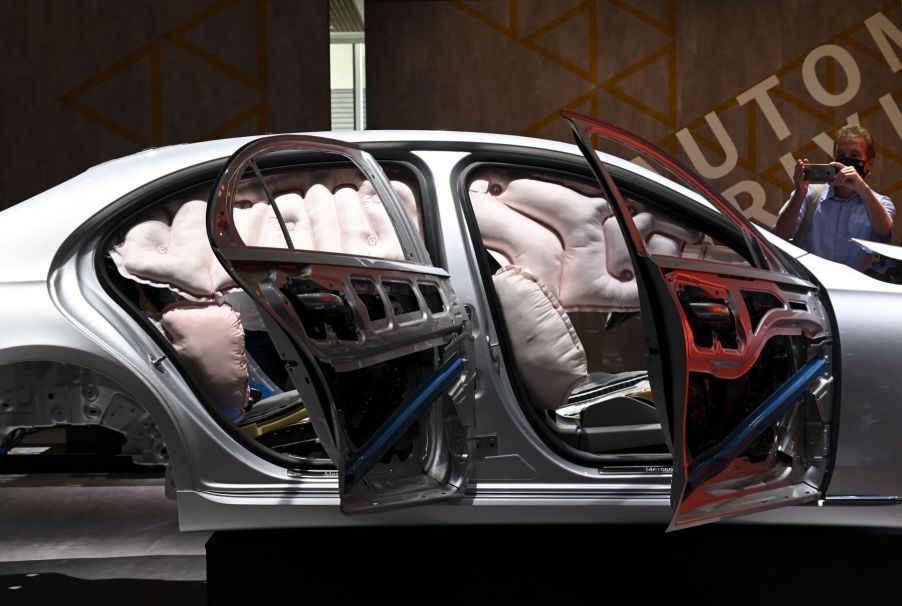
How Many Airbags Should a Car Have?
The automobile industry has seen significant improvement in car safety over the past several decades. Seat belts, airbags, and other technological advances have proven essential in protecting and saving lives. In fact, as of 1999, all passenger vehicles must come equipped with front airbags.
Although not mandated by law, most automakers also include side airbags as a standard safety feature. There are several other kinds of airbags, with one type that is not as effective, possibly doing more harm than good when involved in a collision. Since each make and model of a vehicle is different, it can be hard to differentiate how many airbags a car needs to provide the most protection for all occupants.
Are airbags really effective at protecting car occupants?

Some negative news stories have featured faulty airbags, occupant injuries, and Takata airbag recalls in recent years. Rest assured, advanced sensing systems are now in place to provide safer, more sophisticated results. In fact, the National Highway Traffic Safety Administration (NHTSA) estimates more than 50,000 lives have been saved by airbag use over the past 30 years.
The inflatable cushions are built into a vehicle to protect passengers during a moderate to severe crash. Designed to work in unison with seat belts, both front and side airbags help prevent an occupant’s head and upper body from hitting the hard surfaces of a vehicle’s interior. Upon impact, a sensor in the system will immediately measure the severity of the crash. Within 1/20th of a second, the module determines if the airbag is needed. When deployed, it will instantly inflate with a non-toxic gas.
The Insurance Institute for Highway Safety (IIHS) claims “airbags are one of the most important safety innovations of recent decades.” According to the IIHS, front airbags can help reduce driver and front-seat passenger fatalities by almost 30 percent. Side airbags can help reduce fatalities in driver-side crashes in a passenger vehicle by 37 percent and an SUV by more than 50 percent.
How many are required by law?
The current law requires that passenger vehicles have two front airbags, one for the driver and one for the front-side passenger. Several other types are optional but can provide additional protection to vehicle occupants. Rear-window curtain installations protect back seat passengers when the vehicle is involved in a rear-end accident. Far-side airbags are designed to prevent front-seat passengers from bumping into one another during a crash. Knee airbags are located in the lower dashboard and are designed to reduce leg injuries by redistributing the force of the impact and limiting lower body movement. However, according to the IIHS, these knee installations have proven to be unnecessary and, in some cases, may have a “negligible effect on injury risk and, in fact, may even increase it in some cases.”
Some automakers are installing additional airbags as a marketing ploy to attract safety-conscious consumers. Motor and Wheels reported that the Chevy Malibu sedan, Toyota Camry, Nissan Sentra, and Chevy Impala have 10 airbags installed on their vehicles.
Meanwhile, CNN Money discovered that “Fewer, better designed airbags in a well-engineered car body are worth more than a whole bunch of airbags in a car that offers little protection on its own.”
The future of airbag technology
As technology continues to evolve, there will soon be inflatable safety belt airbags that will help to reduce chest injuries. Ongoing research is focusing on the use of predictive technology that will anticipate a crash before it happens.
MotorBiscuit learned that the 2021 Acura TLX utilizes an advancement system that will deploy a three-chambered unit to cradle the passenger’s head. The new design will help to eliminate brain injury when vehicles are involved in a catastrophic crash.
According to Automobile Industry, “manufacturers are focusing on developing nylon-based fabrics coated with organic silicon instead of neoprene, as these coated fabrics have a longer service life, stable performance, high wear resistance, and are lightweight.”


